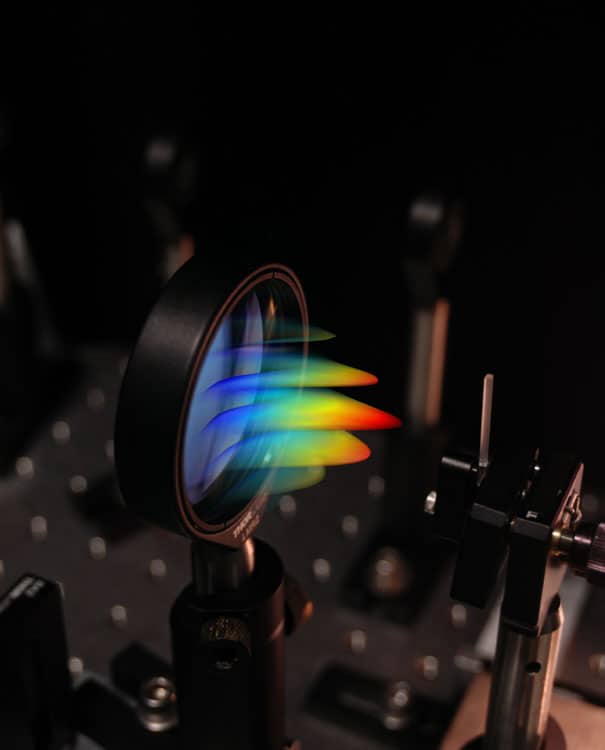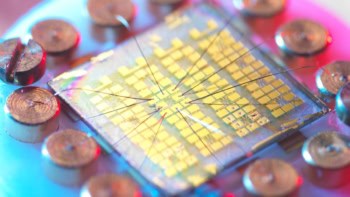
In the orthodox interpretation of quantum mechanics, the wavefunction contains the maximal knowledge that is available about the state of a system. It determines the probabilities that various results will be obtained when measurements are made on the dynamic variables of the system such as its position or momentum.
However, measuring the wavefunction is no easy task. Thanks to Heisenberg’s uncertainty principle, measuring a quantum system without effectively destroying it before the wavefunction is fully known has seemed impossible. Now, by taking a new approach to quantum measurement, Jeff Lundeen and his team from the National Research Council, Canada, have directly measured the wavefunction of identical single photons for the first time.
Making a measurement on just one copy of a system – such as just a single photon – gives us part of the wavefunction. However, the measurement must be repeated many times on an ensemble of identical photons to gain enough information to construct the entire wavefunction. This indirect form of measurement is known as “quantum tomography” and has been used for some time.
Recording ripples
Lundeen likens tomography to mapping the shape of a ripple on the surface of a pond (the wavefunction) by taking snapshots of the shadows of the ripples on the bottom. By combining information from many snapshots, the shape of the ripple can be inferred. In quantum tomography, however, each snapshot measurement is so “strong” that it destroys the ripple and the process must be repeated with identical ripples. Beyond the destructive nature, certain wavefunctions such as atomic or molecular orbitals cannot be determined using tomography.
Instead of focusing on the shadows, the team has worked out a way to directly probe both the real and imaginary parts of the wavefunction of an ensemble of photons. The method relies on the concept of “weak measurement”, which has been used recently to measure some quantum systems – and does not destroy the wavefunction.
“Our understanding of the wavefunction is rather abstract and there is no official textbook definition,” says Lundeen. “We decided to look into the method of weak measurements irrespective of how wary scientists seem to be of it,” he continues, explaining that, although the theory of weak measurements was developed in the 1980s, it was dismissed by many researchers because it produced rather “odd results” that were much larger than expected. The reason for the unexpected results, explains Lundeen, is that a weak measurement gives a complex number – it has a real part and an imaginary part.
Gentle measurements
The theory of weak measurement says that it is possible to “gently” or “weakly” measure a quantum system and to gain some information about one property (say, position) without appreciably disturbing the complementary property (momentum) and therefore the future evolution of the system. Though the information obtained for each measurement is tiny, an average of multiple measurements gives an accurate estimation of the measurement of the property without distorting its final value.
For a generic quantum measurement, the system to be measured is coupled with another state that can be thought of as a “pointer”. Information about a measured property is gained by observing a change in the position of the pointer. Generally, this is considered to be a strong measurement because there is little overlap between the original and final positions of the pointer. The detection of a photon in a CCD, for example, would swing the pointer from zero photons to one but result in the destruction of that photon.
In a weak measurement, it is just the opposite, with the final position of the pointer overlapping to a large extent with its initial position. In the measurement carried out by the team, the real part of the wavefunction is given by a small shift of the pointer related to the position of the photon. The imaginary part of the wavefunction is given by a shift of the pointer related to the momentum of the photon. So the position is weakly measured while the momentum is strongly measured.
Four basic steps
The experiment has four basic steps. The first is to generate a stream of single photons with identical wavefunctions. “It is virtually impossible to measure a wavefunction with just one copy of a quantum system (i.e. one photon), this we are almost sure of,” explained Lundeen. The team either used an attenuated laser beam or a process known as spontaneous parametric down-conversion (SPDC) to produce its photon stream.
The next step is to set up the weak measurement of the transverse position of the photon by inducing a rotation in each photon’s polarization by a very small amount – 10° – using a quartz crystal. Because the polarization change is small, the system is not greatly disturbed.
The photons are then collimated and only photons travelling in a specific direction are detected – a process called post-selection. This is the strong measurement. In the final step, the weak measurement is carried out by measuring the two types of polarization that have actually occurred in the photons post-collimation. This is two-fold because the real part of the measurement is the actual amount of linear rotation that has occurred and the imaginary part is given by the circular rotation or the “ellipticity” of the polarization that has occurred. Together, these values give the weak measurement of the wavefunction. The researchers repeated the measurement for photons with different wavefunctions to confirm the accuracy of the results.
Better than tomography?
Lundeen points out that the signal-to-noise ratio of his team’s experiment was rather good. Indeed, he says that an important benefit of the weak measurement technique is that the results are amplified. Therefore it could prove to be especially useful for studying systems that are currently very hard to measure.
While he believes that there will still be a place for quantum tomography, Lundeen feels that certain systems will benefit from the technique used by his team. “While tomography is a global measurement that is more a reconstruction of the wave function, our measurement is local and direct.” he explained. “The simple benefit of our research is that we now have an operational textbook definition of a wavefunction…something that is essential.”
The research was reported in Nature.
A preprint of the paper can be found at arXiv: 1112.3575.



